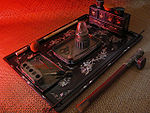
Opium pipe
Encyclopedia

Opium
Opium is the dried latex obtained from the opium poppy . Opium contains up to 12% morphine, an alkaloid, which is frequently processed chemically to produce heroin for the illegal drug trade. The latex also includes codeine and non-narcotic alkaloids such as papaverine, thebaine and noscapine...
. True opium pipes allow for the drug to be vaporized while being heated over a special oil lamp known as an opium lamp
Opium lamp
An opium lamp is an oil lamp designed specifically to facilitate the vaporization and inhalation of opium. Opium lamps differ from conventional lamps for lighting in that they are designed to channel an exact amount of heat upward through their funnel-shaped chimneys...
. It is thought that this manner of "smoking" opium began in the seventeenth century when a special pipe was developed that vaporized opium instead of burning it. http://www.opiummuseum.com/index.pl?pics&59
The configuration of the typical opium pipe consists of a long stem, a ceramic pipe-bowl, and a metal fitting, known as the "saddle", through which the pipe-bowl plugs into the pipe-stem. The pipe-bowl must be detachable from the stem due to the necessity to remove the bowl and scrape its insides clean of opium ash after several pipes have been smoked. The stems of opium pipes were usually made from bamboo, but other materials were used such as ivory, silver and jade, to name a few. Pipe-bowls were typically some type of ceramic, including Yixing clay
Yixing clay
Yixing clay is a type of clay from the region near the city of Yixing in Jiangsu province, China. Its use dates back to the Song Dynasty when purple clay was first mined around Lake Taihu in China. From the 17th century on, the ware was commonly exported to Europe. The finished stoneware, which...
and blue and white porcelain. Sometimes opium pipe-bowls were carved from more valuable materials such as jade. http://www.opiummuseum.com/index.pl?pics&65
Because of its design, the opium pipe needed an opium lamp in order to function. The lamp was as highly specialized as the pipe, and was designed to channel just the right amount of heat upon the pipe-bowl so that the opium would vaporize and allow the smoker to inhale the intoxicating vapors.
Due to opium eradication campaigns in the nineteenth and early twentieth centuries, genuine opium pipes are now extremely rare. http://www.opiummuseum.com/index.pl?pics&63
Further reading
- Steven Martin, The Art of Opium Antiques (Silkworm Books, 2007). Photograph-driven descriptions of antique Chinese and Vietnamese opium smoking paraphernalia.

